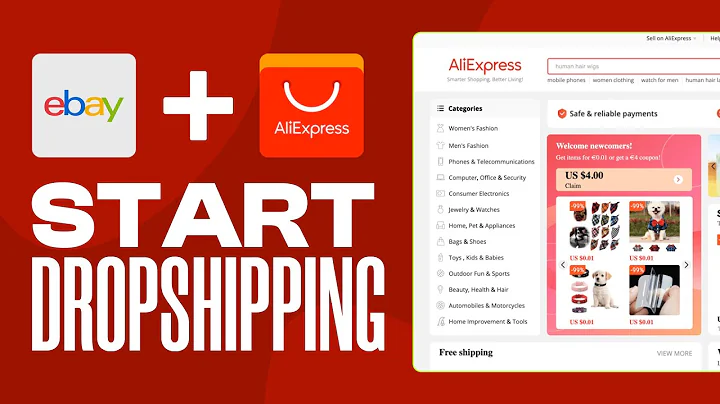Ultimate Guide to BigCommerce Dropshipping
Table of Contents
- Introduction to BigCommerce dropshipping
- Step 1: Registration and Setting Up
- Step 2: Customizing Your Dashboard
- Step 3: Adding a Product
- Step 4: Setting Up Shipping
- Step 5: Accepting Payments
- Step 6: Setting Up Tax Rates
- Step 7: Customizing Your Online Store
- Step 8: Familiarizing Yourself with the BigCommerce Dashboard
- Step 9: Understanding Dropshipping
- Step 10: Choosing the Right Dropshipping Apps for BigCommerce
- Step 11: Planning for Your Dropshipping Business
- Step 12: Selecting the Right Product Niche
- Step 13: Promoting Your Dropshipping Business
- Conclusion
Introduction to BigCommerce Dropshipping
In this tutorial, we will explore the world of BigCommerce dropshipping and provide you with a step-by-step guide on how to set up and scale your online store. BigCommerce is a popular e-commerce platform that allows entrepreneurs to easily create their own online stores. With dropshipping, you can sell products without the need to keep inventory or worry about shipping. It's a low-risk, scalable business model that can be highly profitable. So, let's dive in and learn everything you need to know about BigCommerce dropshipping.
Step 1: Registration and Setting Up
To get started with BigCommerce dropshipping, the first step is to sign up and register with BigCommerce. This platform is one of the leading players in the e-commerce industry, offering a range of features and functionalities. During the registration process, you will need to provide your email address and specify your industry and current selling platforms. BigCommerce offers a 15-day free trial, allowing you to explore the platform before making any commitments. Once you have completed the registration, you will receive an email confirmation. Log in to your store using the provided credentials and update your password to customize your store further.
Pros:
- BigCommerce is one of the largest players in the e-commerce market, offering a wide range of features and functionality.
- The platform provides secure payment portals and allows you to build your brand.
- BigCommerce offers a variety of professional website templates to choose from.
Cons:
- Limited to the capabilities and constraints of the BigCommerce platform.
- May require additional third-party apps or integrations for specific functionalities.
Step 2: Customizing Your Dashboard
After logging into your BigCommerce store, it's time to customize your dashboard. The dashboard serves as the central hub for managing your store and accessing various tools and features. You can personalize your dashboard by adding widgets, rearranging the layout, and prioritizing the information that matters most to you. Customizing your dashboard allows for better organization and efficiency in managing your dropshipping business. Make sure to familiarize yourself with the available options and functionalities to maximize your productivity.
Step 3: Adding a Product
One of the most crucial steps in setting up your BigCommerce dropshipping store is adding products. Adding a product involves providing basic information, such as descriptions, imagery, pricing, inventory details, and product identifiers. You can also set up variations and customizations, such as different sizes or colors. Additionally, BigCommerce allows you to link related products, specify fulfillment options, shipping details, and even enable gift wrapping. It's essential to ensure that your product listings are optimized for search engines and provide accurate and compelling information to attract potential customers.
Step 4: Setting Up Shipping
Shipping is a vital aspect of any e-commerce business, and BigCommerce offers various options and configurations to suit your needs. To set up shipping, you will need to specify the origin address and select the desired shipping options. BigCommerce allows you to create default shipping rules, define advanced shipping roles, and even integrate with third-party shipping apps like ShipperHQ for more control and flexibility. You should also consider including shipping labels and recommended services to streamline the fulfillment process and provide a smooth experience for your customers.
Step 5: Accepting Payments
Next, you need to set up payment processing to ensure smooth, secure, and convenient transactions for your customers. BigCommerce integrates with popular payment gateways like PayPal, Stripe, Square, and more. By enabling these payment methods, your customers can easily make purchases using their preferred payment options. Additionally, you may consider enabling digital wallets such as Amazon Pay, Apple Pay, Google Pay, and Masterpass to expand your reach and cater to a wider customer base. Don't forget to enable test credit card payments during the setup process to ensure everything is functioning correctly.
Step 6: Setting Up Tax Rates
Tax rates and compliance are crucial considerations for any e-commerce business. With BigCommerce, you can easily set up tax rates based on your location and the jurisdictions you serve. Specify the applicable tax rules, including product categories, shipping destinations, and any exemptions. BigCommerce also provides integration with tax calculation services like Avalara, TaxJar, and TaxCloud for accurate and automated tax calculations. It's essential to ensure compliance with tax regulations to avoid any legal issues and provide transparency to your customers.
Step 7: Customizing Your Online Store
To make your BigCommerce dropshipping store unique and visually appealing, you need to customize its look and feel. BigCommerce offers a wide range of professionally designed themes that you can choose from. Select a theme that aligns with your brand identity and customize it by adding your logo, selecting color schemes, and adjusting the layout to create a cohesive and branded experience for your customers. By customizing your online store, you can make it stand out from the competition and leave a lasting impression on your visitors.
Step 8: Familiarizing Yourself with the BigCommerce Dashboard
Now that your store is set up, it's essential to familiarize yourself with the BigCommerce dashboard and its various features. The dashboard provides access to critical store management tools, including order management, inventory tracking, customer support, analytics, and marketing options. By exploring and understanding the dashboard, you can efficiently navigate your way through the different sections and make the most out of the platform's capabilities.
Step 9: Understanding Dropshipping
Dropshipping is the backbone of your BigCommerce dropshipping business. It allows you to sell products without the need for inventory or shipping. When a customer places an order on your store, the order is directly transferred to your dropshipping supplier, who is responsible for fulfilling the order and shipping it directly to the customer. Dropshipping offers several advantages, including minimal upfront costs, scalability, and low overheads. However, it also comes with challenges such as customer support and the reliance on third-party suppliers.
Pros:
- Minimal upfront costs due to no inventory expenses.
- Scalable business model with the potential for growth.
- Low business overheads, such as storage fees and payroll costs.
- Access to a wide variety of products from different suppliers.
- Ability to test and enter new markets with reduced risks.
Cons:
- Responsibility for customer support and dealing with inquiries and issues.
- Reliability and trustworthiness of dropshipping suppliers can vary.
- The challenge of standing out in a competitive market.
Step 10: Choosing the Right Dropshipping Apps for BigCommerce
To automate and enhance your dropshipping business and streamline operations, you need to leverage the right dropshipping apps. BigCommerce offers an app store where you can find a variety of dropshipping apps that integrate seamlessly with the platform. Some popular apps include Printful, Sprocket, Modalyst, Printify, SaleHoo, AliExpress, and Dropified. These apps provide features like product sourcing, inventory management, automated order fulfillment, and more. Choosing the right dropshipping apps plays a significant role in improving efficiency and reducing manual tasks.
Step 11: Planning for Your Dropshipping Business
Planning is a crucial aspect of any successful business, including dropshipping. Before launching your big-commerce dropshipping store, you need to take care of several essential elements. This includes selecting and registering your business name, determining the appropriate legal structure, obtaining necessary licenses and permits, and developing a branding strategy. Additionally, consider accounting and banking requirements to ensure proper financial management. Planning ensures that your business is legally compliant, financially stable, and well-positioned for growth.
Step 12: Selecting the Right Product Niche
The product niche you choose plays a significant role in the success of your dropshipping business. It's important to select a niche that aligns with your interests, expertise, and passion. Choosing a niche you love allows you to better understand your target audience and their needs. It also gives you a competitive advantage in selecting the right products and implementing effective marketing strategies. To identify a profitable product niche, you can use tools like Google Trends, e-commerce giants like Amazon and eBay, and conduct competitor analysis to gauge market demand and trends.
Step 13: Promoting Your Dropshipping Business
To drive traffic and generate sales for your BigCommerce dropshipping store, you need to implement effective promotion strategies. One way is to leverage your existing email list or build one through lead generation techniques. Craft compelling email campaigns to engage your audience and entice them to visit your store. Social media platforms like Facebook, Instagram, and Pinterest can also be powerful marketing channels. Create engaging content, run targeted ads, and leverage social selling techniques to attract potential customers. Additionally, consider optimizing your store for search engines to improve visibility and organic traffic.
Conclusion
In this tutorial, we covered the essential steps to set up and scale your BigCommerce dropshipping business. From registration and customization to product selection and promotion, each step is crucial for your success. BigCommerce offers a robust platform that enables entrepreneurs to create professional online stores and leverage the benefits of dropshipping. With proper planning and execution, you can build a profitable and sustainable business in the ever-growing e-commerce industry. So take action, start your BigCommerce dropshipping journey, and watch your business thrive.



















